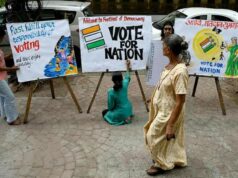Police Opens Fire On Violent Mob Trying To Snatch Body Of Killed Terrorist Dogs, Woman Injured
 Police opened fire on a violent mob attempting to seize the body of a jihadist terrorist killed in a shootout with security forces.
Police opened fire on a violent mob attempting to seize the body of a jihadist terrorist killed in a shootout with security forces.
Local resident Shahnawaza Koka, part of the violent mob received gunshot injuries to both legs, becoming the first civilian injured in the use of live ammunition by police.The stone-throwing mob was seeking to prevent the body of Burhan Majeed Koka, the commander of Ansar Ghazwat’ul Hind, al-Qaeda’s regional affiliate in Kashmir, from being moved from the site of the shootout in his native village of Melhora, near Shopian in southern Kashmir.
Earlier this month, the authorities in Jammu and Kashmir initiated a policy of conducting the last rites of bodies of terrorists killed in combat, rather than handing them over families, a move intended to prevent pro-jihadist rallies that have erupted in parts of southern Kashmir in recent weeks.
Late on Wednesday afternoon, police sources said, about 1,500 people gathered to stage a Ghaibana Namaz-e-Janaza or funeral rites held without the presence of the body of the deceased, in Mailhora.
The sources said smaller mobs also attacked traffic near a railway crossing in Naina Batpora near Shopian.
Another local resident, identified by hospital authorities as Mohammad Asif, received injuries from birdshot — pellets fired from a riot-control shotgun — on his upper body, government sources said.
Koka, police said, was buried with full religious rites at a graveyard elsewhere in south Kashmir.
The 56th jihadist killed in a series of exceptionally successful counter-terrorism operations since January, Koka was appointed head of the Ansar Ghazwat’ul Hind in October, after the killing of his predecessor Abdul Hamid Lone, also known as Abdul Hameed Lelhari.
Both men were close associates of the Ansar Ghazwat’ul Hind’s founder, Zakir Bhat, also known as Zakir Musa, who was killed in May, 2019.
A one-time bachelor of sciences student, intelligence sources said, the 23-year-old Koka had dropped out of college in May, 2018, to join Zakir Bhat in the Hizb-ul-Mujahideen.
Police records show Koka’s father, Abdul Majeed Koka, served in the Hizb-ul-Mujahideen in the 1990s, before surrendering to police.
Although details are sketchy, police believe Koka trained with the Hizb-ul-Mujahideen in Pakistan for some months in 2018 before he returned and joined the Ansar Ghazwa’tul Hind.
Formed by dissident jihadists angered by what they saw as the Hizb-ul-Mujahideen’s excessive dependence on Pakistan and its intelligence services, the Ansar Ghazwat’ul Hind was initially criticised by secessionist leaders like Syed Ali Shah Geelani and Mirwaiz Umar Farooq.
In one statement, Mirwaiz asserted that the secessionist movement in Kashmir “had nothing to do with these world-level groups and they are practically non-existent in the state.”
In response, Zakir Bhat threatened to behead the secessionist political leaders “and hang their heads in Lal Chowk”. He broke ranks with the Hizb-ul-Mujahideen, and joined al-Qaeda in 2017.
Large-scale clashes between pro-jihadist mobs and police were cited as among the reasons central government rule was imposed in Kashmir last year, along with sweeping restrictions on movement and internet access.
However, clashes, often centred around the killings and burials of jihadists, have again become a feature of Kashmir’s fraught landscape, government sources said.
Earlier this week, Kulgam residents Sameer Ahmad Beigh, Mehran Ahmed and Khurshid Ahmed Padder received birdshot injuries after police used shotguns against a mob at an encounter site near Lower Munda, in Kulgam district.
In mid-March, three people in Srinagar also received birdshot injuries, after protests against the demolition of illegal construction by the Srinagar Municipal Corporation turned violent.
“There’s no doubt that clashes with mobs have declined,” a senior police officer said, adding, “But there are worrying signs that the process could be reversing”.
“In the absence of any competition from pro-India politicians, the jihadists are becoming the focal points for resentments against the local administration and the quality of governance,” he added.
Earlier this month, several hundred people gathered for the burial rites of slain Jaish-e-Muhammad terrorist Sajjad Nawab Dar in Sopore, defying restrictions on gatherings.
The burial of Hizbul Mujahideen’s Mohammed Ashraf Malik in Kulgam’s Arwani also drew large crowds.
Large-scale attendance at jihadist funerals, which later escalated into clashes with police at encounter sites, had started in 2015, when large crowds had begun assembling in Kashmir with the funeral Lashkar-e-Taiba jihadist Abdul Rehman, also known as Abu Qasim.



